Christianity has used symbolism from its very beginnings.[1] Each saint has a story and a reason why he or she led an exemplary life. Symbols have been used to tell these stories throughout the history of the Church. A number of Christian saints are traditionally represented by a symbol or iconic motif associated with their life, termed an attribute or emblem, in order to identify them. The study of these forms part of iconography in art history. They were particularly used so that the illiterate could recognize a scene, and to give each of the saints something of a personality in art. They are often carried in the hand by the saint.
Attributes often vary with either time or geography, especially between Eastern Christianity and the West. Orthodox images more often contained inscriptions with the names of saints, so the Eastern repertoire of attributes is generally smaller than the Western. Many of the most prominent saints, like Saint Peter and Saint John the Evangelist can also be recognised by a distinctive facial type – as can Christ. In the case of later saints their actual historical appearance can also be used; Saint Bernardino of Siena (1380–1444) is one of the earliest whose distinctive appearance was well-known from early prints and is nearly always used by artists. Some attributes are general, such as the palm frond carried by martyrs.
The use of a symbol in a work of art depicting a saint reminds people who is being shown and of their story. The following is a list of some of these attributes.
List
Contents
- Top
- A
- B
- C
- D
- E
- F
- G
- H
- I
- J
- K
- L
- M
- N
- O
- P
- Q
- R
- S
- T
- U
- V
- W
- X
- Y
- Z
A
| Saint |
Symbol |
| Acathius of Melitene | Crown of Thorns |
| Agatha of Sicily | tongs or shears, veil, bells, two breasts on a plate |
| Agnes | lamb |
| Alfred the Great | Codex, crown, orb/scepter |
| Ambrose | bees, beehive, dove, ox, pen |
| Andrew | Saltire |
| Anne, grandmother of Jesus | door, book, red robe and green mantle |
| Anthony the Great | monk's habit, bell, pig |
| Anthony of Padua | Child Jesus, bread, book, lily |
| Athanasius of Alexandria | Bishop arguing with a pagan, bishop holding an open book, bishop standing over a defeated heretic |
| Augustine of Hippo | dove, child, shell, pen, book |
B
| Saint |
Symbol |
| Barbara | tower, ciborium, cannon |
| Bartholomew the Apostle | knife, human skin |
| Benedict | broken cup, raven, bell, crosier, bush |
| Bernard of Clairvaux | pen, bees, instruments of the Passion |
| Bernardino of Siena | tablet or sun inscribed with IHS, three mitres |
| Blaise | wax, taper (candle), iron comb |
| Bonaventure | communion, ciborium, cardinal's hat |
| Boniface | oak, axe, book, fox, scourge, fountain, raven, sword |
| Bridget of Sweden | book, pilgrim's staff |
| Brigid of Kildare | cow, crosier, Brigid's cross |
C
Clare of Montefalcocross
| Saint |
Symbol |
| Catherine of Alexandria | wheel, crown, sword, book |
| Catherine of Ricci | ring, crown, crucifix |
| Catherine of Siena | stigmata, cross, ring, lily |
| Cecilia | organ |
| Cerbonius | geese |
| Charles Borromeo | cardinal's robes, communion |
| Christopher | giant crudely dressed, torrent, tree, branch or large staff, Carrying the Child Jesus on shoulder |
| Clare of Assisi | monstrance |
| Clement | anchor, fish, Mariner's Cross |
| Corbinian | saddled bear |
| Saints Cosmas and Damian | a phial, box of ointment |
| Cyriacus | deacon's vestments |
D
E
| Saint |
Symbol |
| Edmund the Martyr | quiver of arrows |
| Saint Eligius | bishop portrayed with a crosier in his right hand, on the open palm of his left a miniature church of chased gold; with a hammer, anvil, and horseshoe; or with a horse |
| Elijah | cave |
| Elisabeth of Hungary | alms, flowers, bread, the poor, pitcher |
| Emilianus | monk on horseback |
| Elizabeth of Portugal | crown |
| Erasmus of Formiae | windlass |
| Eustace | hunting clothes, stag, bull, crucifix, horn, oven |
F

An axe, the symbol of the martyrdom of
Judas Thaddeus and other saints
G
| Saint |
Symbol |
| Gabriel | is archangel, trumpet, armour, wings, scroll stating “Ave Maria Gratia Plena” |
| Genesius | theatre mask |
| Genevieve | lit candle, bread, keys, herd, cattle |
| George | dragon,soldier or knight in armour, often on white horse, especially in the East, Cross of Saint George |
| Gertrude of Nivelles | crown, tapir, lily, mouse |
| Giles | Benedictine habit, hind |
| Gregory the Great | Papal Tiara, crosier, dove (often portrayed at his ear) |
H
I
J
| Saint |
Symbol |
| James, son of Zebedee | pilgrim's staff, scallop shell, key, sword, Pilgrim's hat, astride a white charger, Cross of Saint James |
| James, son of Alphaeus / James the Just | square rule, halberd, club, saw |
| Jerome | lion, cardinal clothing, cross, skull, books and writing material, stone in hand |
| Joan of Arc | shield, Cross of Lorraine |
| Saint Joanna | lamb |
| John Berchmans | Rule of Saint Ignatius, cross, rosary |
| John Chrysostom | bees, dove, pen |
| John of God | alms, heart, Crown of Thorns |
| John the Baptist | lamb, head on a platter, animal skin (the camel-skin coat of the Gospels), pointing at Christ or a lamb, often portrayed carrying a long crudely made cross |
| John the Evangelist | eagle, chalice sometimes with a snake in it, kettle, book |
| Joseph, spouse of Mary | Child Jesus, lily, rod, plane, carpentry square, purple robe and brown mantle |
| Juan Diego | Tilmàtli |
| Jude the Apostle | sword, square rule, club, ship |
| Justin Martyr | axe, sword |
| Justina of Padua | palm frond, knife, unicorn |
| Juthwara | round soft cheese |
K
L
| Saint |
Symbol |
| Lambert of Maastricht | palm of martyrdom |
| Lawrence of Rome | cross, Gospel Book, gridiron, palm frond, purse of money, attired as a deacon in a dalmatic, accompanied by a group of poor people. |
| Leander of Seville | pen |
| Leonard of Noblac | lock, chain, manacles or fetters |
| Liborius of Le Mans | pebbles, peacock |
| Louis IX of France | Royal attire of crown and blue robe decorated with golden fleur-de-lis, Crown of Thorns, nails |
| Lucy | cord, eyes on a dish, lamp |
| Luke the Evangelist | ox, book, brush, palette |
M
| Saint |
Symbol |
| Margaret of Scotland | reading |
| Margaret the Virgin | dragon in chains |
| Mark the Evangelist | winged lion, book |
| Martha | aspergillum, dragon |
| Martin of Tours | goose |
| Martin of Porres | broom, a cat, dog and a mouse eating from the same plate |
| Mary Magdalene | jar of ointment, red egg |
| Matilda of Ringelheim | purse, alms |
| Matthew the Evangelist | winged man, purse, lance |
| Maurus | scales, spade, crutch |
| Michael | scales, banner, sword, dragon |
| Monica | girdle, tears |
N

three purses or balls
O
| Saint |
Symbol |
| Oda of Scotland | depicted wearing a long blue gown with one shoulder bare; usually carries a staff or a book; always shown with a magpie on her hand and a crown under her feet |
| Olaf of Norway | axe in Norway's coat of arms |
P
| Saint |
Symbol |
| Pantaleon | nailed hands |
|
| Patrick | cross, harp, serpent, baptismal font, demons, shamrock |
| Paul the Apostle | sword, book or scroll, horse Long, pointed beard; balding backwards from forehead. Green robe, red mantle. |
| Peter | keys, boat, rooster, square white beard and short, curling white hair, bald on top. Blue robe and yellow mantle. |
| Saint Peter of Verona | Dominican with a hatchet in his head or a severe head wound; or writing the words "Credo in unum Deum" as he dies |
| Petronilla | set of keys, dolphin |
| Philip the Apostle | column |
| Philip Neri | lily |
| Philomena | anchor, palm, arrows |
Q

Young man with two spits
| Saint |
Symbol |
| Quentin | depicted as a young man with two spits; as a deacon; with a broken wheel; with a chair to which he is transfixed; with a sword; or beheaded, a dove flying from his severed head |
| Quiteria | depicted with a dog on a lead; depicted with her head in her hands, emerging from the sea. |
R
| Saint |
Symbol |
| Raphael | fish |
| Rita of Cascia | roses, roses and figs, crucifix, thorn, sometimes with a wound in her forehead |
| Roch | angel, dog with bread, leg wound, pilgrim's dress |
| Rose of Lima | Crown of Thorns, anchor, city, roses |
S
T
U
V
W

Crosier of arcbishop Heinrich of Finstingen, 1260–1286
X
| Saint |
Symbol |
| Xystus | Book, papal tiara, martyr's palm |
Y

Mitre of Bishop Sztojkovics,
Hungary, ca. 1860, stolen in 1989
Z
Further reading
- Walsh, Michael (2007). A New Dictionary of Saints: East and West. Liturgical Press. ISBN 978-0-8146-3186-7.
See also
External links
References



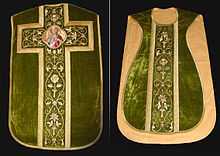
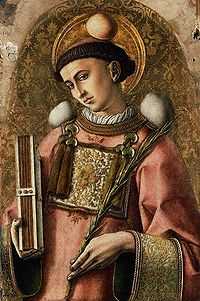


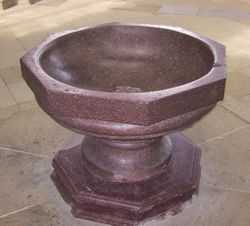


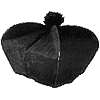






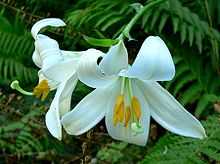

.jpg)



